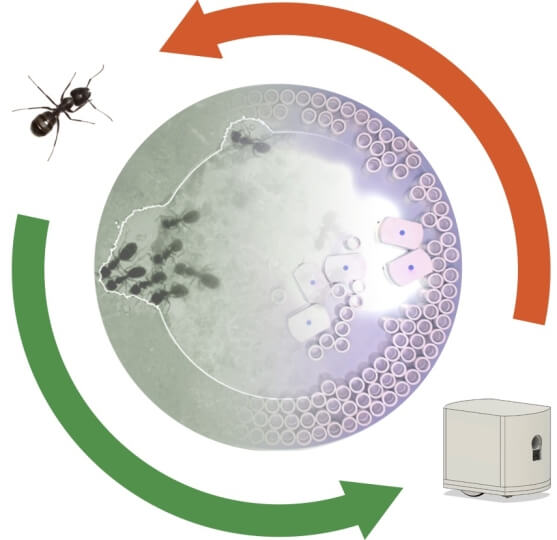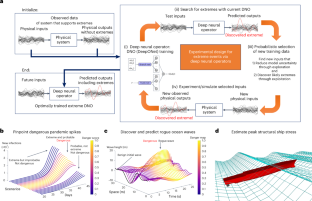アリとロボットが計画も立案もなしに脱獄を成功させる方法 How ants and robots pull-off a prison escape without a plan or a planner
2022-12-19 ハーバード大学

Mahadevan and his team studied real ants and developed parameters and a model to understand the excavation task of the ants. Driven by this understanding and building upon the models, the researchers built robotic ants, nicknamed RAnts. (Credit: Mahadevan Lab/Harvard SEAS)
最近、ハーバード大学の研究者たちは、アリからヒントを得て、いくつかの基本的なパラメーターだけを用いて集団で働き、複雑な作業を行うことができる比較的単純なロボットのチームを設計しました。この研究は、『ELife』誌に掲載されました。
研究チームはまず、クロオオアリがどのように協力して柔らかい巣箱を掘り出し、そこから脱出するのかを研究しました。
アリは主に触角を使って環境や他のアリと交流しています。研究チームは、アリが自発的に、より頻繁に交流する場所に集まってくることを観察した。やがて、そのような場所の掘削が他の場所よりも速く進み、アリは最終的に巣穴の外に出ていった。
研究者たちは、この理解をもとに、RAntsと名付けたロボットアリを作り、同じような囲いから逃れるために協力し合うことができるかどうかを確かめたのである。RAntsは、化学的フェロモンの代わりに「フォトモン」と呼ばれる、フェロモン場や触角を模倣して動き回るRAntsが残す光のフィールドを利用した。
RAntsは、フォトロモンの場の勾配に従うこと、フォトロモンの密度が高い場所では他のロボットを避けること、フォトロモンの密度が高い場所では障害物を拾い、フォトロモンの密度が低い場所では障害物を落とすこと、という単純な局所ルールによってのみプログラムされた。この3つのルールにより、RAntsは閉じ込められていた場所から素早く脱出することができ、また同様に、実際のアリでは検出が困難な行動領域を探索することができた。
この論文の他の主執筆者はSouvik MandalとFabio Giardinaで、Jordan Kennedyと、分子細胞生物学部のRaymond Leo Erikson生命科学教授Venkatesh N Murthyが共著者となっています。
<関連情報>
- https://seas.harvard.edu/news/2022/12/physical-intelligence-ant-and-robot-collectives
- https://elifesciences.org/articles/79638
アリおよびロボット集団における協調的な掘削のダイナミクス Dynamics of cooperative excavation in ant and robot collectives
S Ganga Prasath,Souvik Mandal,Fabio Giardina,Jordan Kennedy,Venkatesh N Murthy,L Mahadevan
ELife Published:Oct 10, 2022
DOI:https://doi.org/10.7554/eLife.79638
Abstract
The solution of complex problems by the collective action of simple agents in both biologically evolved and synthetically engineered systems involves cooperative action. Understanding the resulting emergent solutions requires integrating across the organismal behaviors of many individuals. Here we investigate an ecologically relevant collective task in black carpenter ants Camponotus pennsylvanicus: excavation of a soft, erodible confining corral. Individual ants show a transition from individual exploratory excavation at random locations to spatially localized collective exploitative excavation and eventual excavate out from the corral. An agent minimal continuum theory that coarse-grains over individual actions and considers their integrated influence on the environment leads to the emergence of an effective phase space of behaviors in terms of excavation strength and cooperation intensity. To test the theory over the range of both observed and predicted behaviors, we used custom-built robots (RAnts) that respond to stimuli to characterize the phase space of emergence (and failure) of cooperative excavation. By tuning the amount of cooperation between RAnts, we found that we could vary the efficiency of excavation and synthetically generate the other macroscopic phases predicted by our theory. Overall, our approach shows how the cooperative completion of tasks can arise from simple rules that involve the interaction of agents with a dynamically changing environment that serves as both an enabler and a modulator of behavior.



